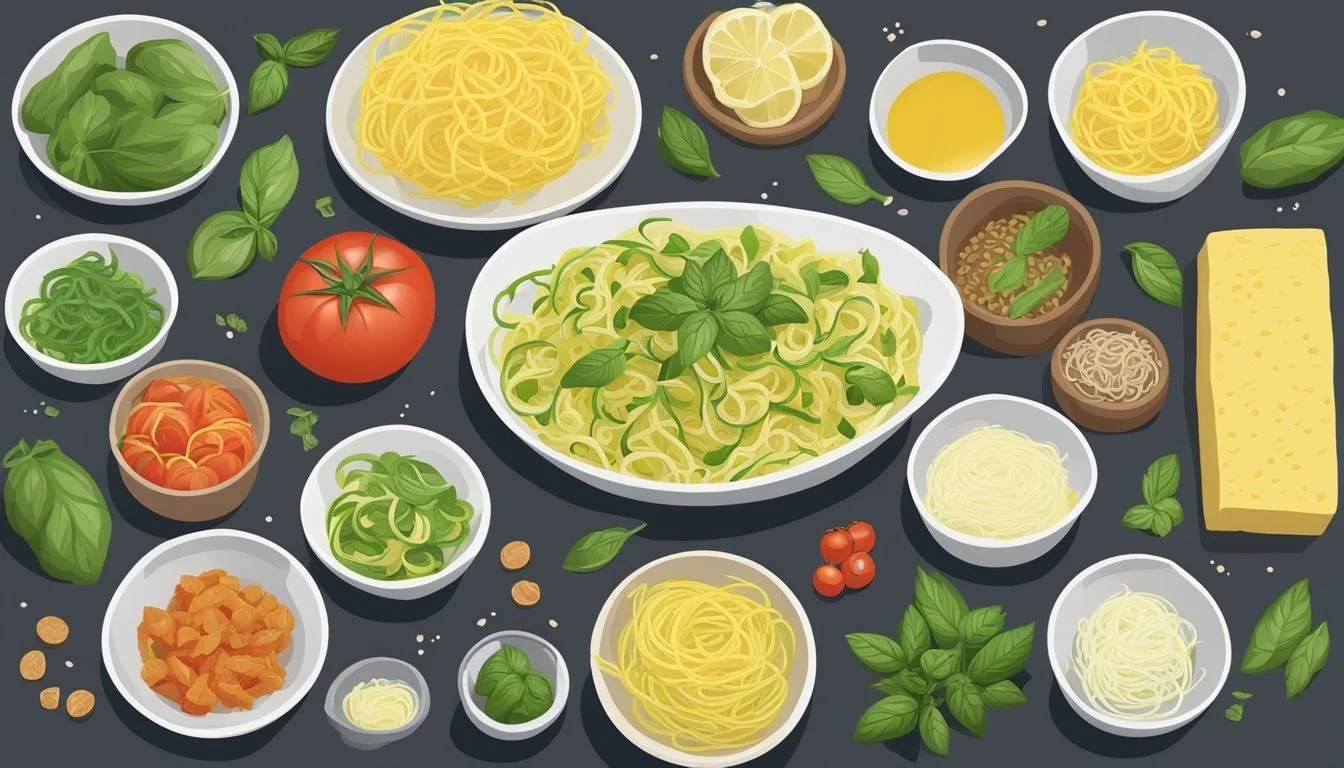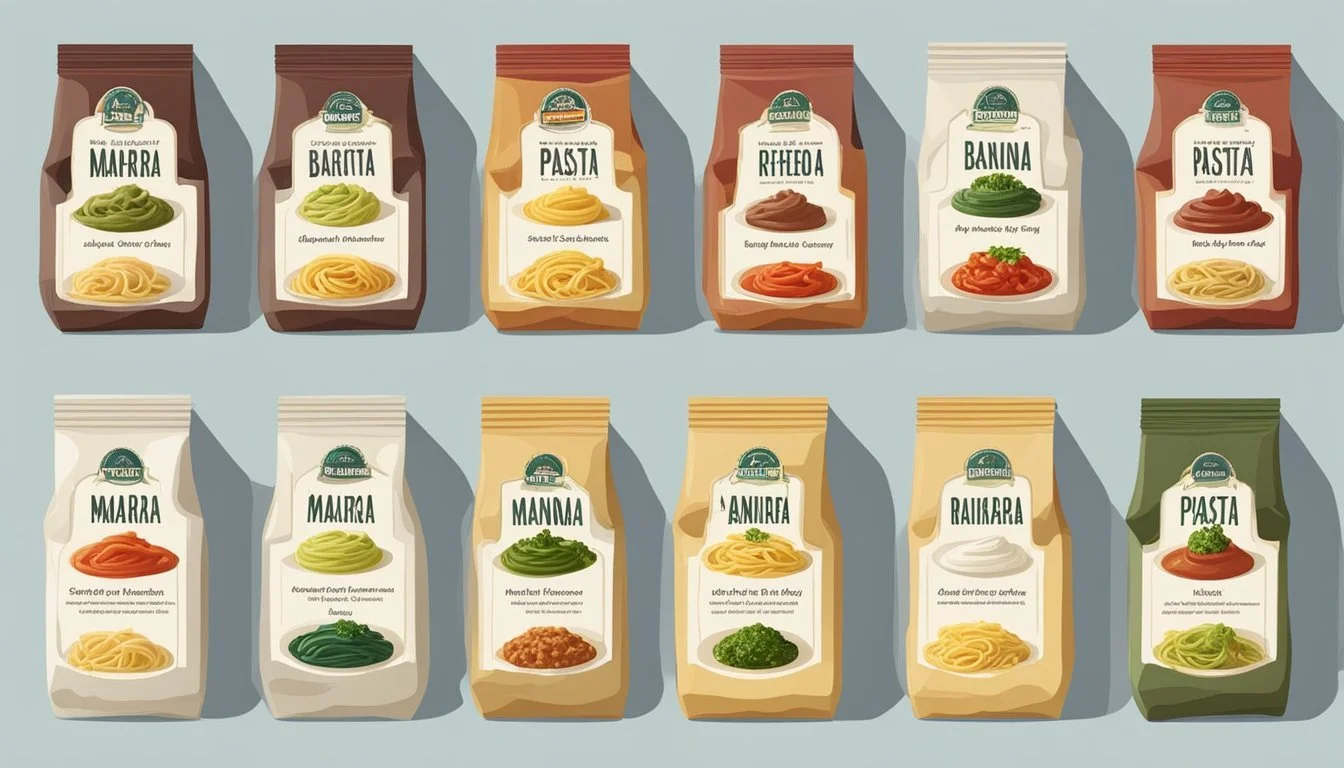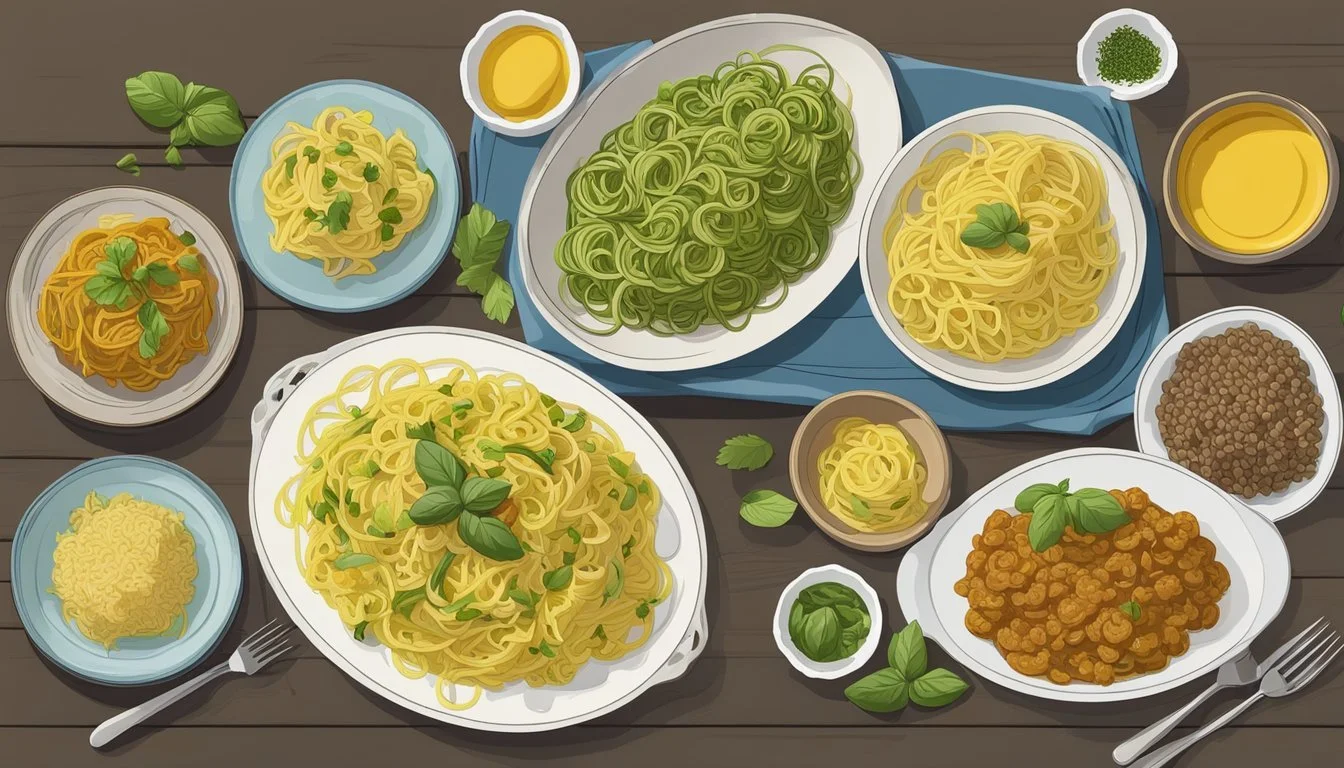Bavette Pasta Substitutes
Top Alternatives for Your Italian Dishes
Bavette pasta (What wine goes well with pasta?), a traditional Italian noodle reminiscent of little ribbons, has a unique and delicate flavor that pairs exquisitely with lighter sauces and seafood. However, those seeking alternatives, whether for dietary preferences, nutritional tweaks, or simply a change in texture, have several options to choose from. Substitutes for bavette pasta not only attempt to match its distinct taste and mouthfeel but also bring their own set of flavors and nutritional benefits to dishes.
For those aiming for a low-carb diet, alternatives like spiralized vegetables can offer a similar long, thin shape with a fresh taste and a substantial decrease in carbohydrate content. These vegetable spirals can be cooked quickly to retain a texture akin to al dente pasta, providing a satisfying bite. Zucchini, squash, and carrots are amongst the most popular vegetable substitutes due to their mild flavors that lend themselves well to a variety of sauces.
Nutrition-conscious individuals may also consider whole-grain options, such as brown rice pasta, which closely mimic the texture of traditional noodles while offering a richer set of nutrients, including fiber. Additionally, legume-based pastas made from lentils or chickpeas also provide both a protein boost and a firm texture, aligning well with the culinary experience bavette pasta is known for.
Understanding Bavette Pasta
Bavette pasta, originating from Italy, is a unique type of pasta distinguished by its shape and thickness. It pairs exceptionally well with a variety of sauces and ingredients.
Characteristics of Bavette
Bavette pasta's defining characteristic is its shape. It resembles long, thin strips, similar to spaghetti but with a noticeable flatness. The thickness of bavette allows it to maintain a firm texture when cooked al dente. Giving exact measurements, each bavette strand is typically no more than 0.25 inches wide and resembles little threads when observed closely.
Bavette and Its Traditional Pairings
Traditionally, bavette pasta is matched with sauces and ingredients that highlight its distinct flavor and texture. Owing to its thickness, it clings well to thicker sauces made with meat, olive oil, garlic, and herbs. Cheeses like Pecorino and Parmigiano are often grated on top, complementing the pasta with a burst of flavor. Bavette pasta effortlessly incorporates the essence of Italy in each perfectly paired dish.
Pasta Substitutes Overview
When seeking alternatives to bavette pasta, one should consider both the nutritional impact and how closely a substitute mimics the characteristics of the original pasta.
Criteria for Substituting Bavette
For an effective bavette substitution, one must assess nutritional value and allergen content. Bavette, similar to fettuccine and tagliatelle, is high in carbohydrates but generally low in fiber and protein. Substitutes often aim to provide a higher fiber content, additional protein, or a reduction in calories. Gluten-free options are also sought after by those with gluten intolerance or celiac disease.
Ideal substitutes include:
Rice noodles: Lower in fiber but gluten-free.
Whole-wheat pasta: Higher in fiber and protein.
Legume-based pasta: High in protein and fiber, gluten-free.
Comparing Shapes and Textures
A direct comparison of bavette, a flat noodle similar in shape to fettuccine and linguine, involves evaluating alternative pasta shapes and textures. It's critical that pasta substitutes mimic the original's ability to hold sauces and offer a comparable mouthfeel.
Pasta Substitute Shape similarity Texture similarity Fettuccine High High Linguine High High Soba noodles Moderate Moderate Zoodles (Zucchini) Low Low
In the quest for a pasta alternative that stays true to bavette's gastronomic experience, choices range from familiar pasta shapes like fettuccine or linguine which are very similar, to more distinct shapes such as spiraled vegetables where the texture diverges significantly. The latter may offer more nutritional benefits, like lower calorie content and a boost in vegetable intake, but the eating experience will differ from traditional pasta dishes (What wine goes well with pasta dishes?).
Vegetable-Based Substitutes
When seeking alternatives to Bavette pasta, one may consider vegetable-based options, which often provide a low-carb alternative rich in fiber. They can offer a more neutral flavor, making them an excellent canvas for a variety of sauces and seasonings.
Spiralized Vegetables
Vegetables such as zucchini, carrots, and beets can be transformed into pasta-like strands using a spiralizer. They are typically:
Low in carbohydrates: Offering a substantial reduction in carbs compared to traditional pasta.
High in fiber: Beneficial for digestive health.
Neutral in flavor: Allowing the natural taste of sauces and dressings to shine through.
Zucchini is one of the most popular choices for spiralizing due to its water content and firm texture, making it resemble the consistency of al dente pasta. Both carrots and beets provide colorful, nutrient-dense alternatives, with carrots adding a subtle sweetness and beets delivering an earthy note.
Starchy Alternatives
For those who desire a closer textural match to pasta with a mild taste, starchy vegetables like spaghetti squash and butternut squash serve as excellent substitutes. They are characterized by:
Spaghetti Squash: When cooked, the flesh pulls apart into threads that resemble spaghetti. A single cup yields only 42 calories and 10 grams of carbs.
Butternut Squash: It boasts a sweet, nutty flavor and pasta-like texture when sliced and roasted. It is rich in vitamins A, C, and E, providing only 45 calories and 12 grams of carbs per cup.
Eggplant is another viable substitute for pasta. When cut into thin strips and lightly cooked, it can mimic the feel of flat noodles and pairs well with both robust and delicate sauces. Grains are generally not used as a direct substitute for pasta in vegetable-based alternatives, but they may serve as an accompaniment to these dishes or as a mixed ingredient in recipes to enhance texture and nutritional value.
Protein-Rich Substitutes
For those looking to maintain a high-protein diet while forgoing traditional bavette pasta, there are numerous suitable alternatives. These substitutes offer a substantial protein content and often present additional dietary benefits such as increased fiber or being gluten-free.
Legume-Based Pasta Substitutes
Chickpea Pasta: A popular choice for its robust protein content, chickpea pasta also brings the benefits of being gluten-free and high in fiber. One serving typically provides around 14 grams of protein, which supports muscle growth and satiety.
Lentil Pasta: Lentils not only contribute a hearty dose of protein, approximately 13 grams per serving, but they also offer a significant amount of fiber. Lentil pasta can be found in various shapes, including rotini, and is a favorable option for nutrient-rich meals.
Edamame Pasta: Made from young soybeans, edamame pasta boasts a protein profile akin to soybean-based products. With edamame as an ingredient, the pasta serves both protein and a full range of essential amino acids.
Black Bean Pasta: Delivering around 14-15 grams of protein per serving, black bean pasta stands out not only for its protein content but also for its unique color and texture. It is also gluten-free and rich in valuable phytonutrients.
Alternative Grains
Quinoa (What wine goes well with quinoa?) Pasta: Quinoa is known for its complete protein, meaning it contains all nine essential amino acids. Quinoa pasta typically offers around 8 grams of protein per serving and is an excellent choice for those looking for gluten-free alternatives.
Brown Rice Pasta: While brown rice pasta may have a modest protein content compared to legume-based options, it is still a good source of protein and fiber. Often enriched, brown rice pasta provides a similar texture and flavor profile to traditional pastas.
Rice Noodles: Generally lower in protein compared to other alternatives, rice noodles can still be part of a protein-rich meal. They are often used in Asian cuisine and provide a gluten-free option suitable for stir-fries and soups.
By incorporating these protein-rich pasta substitutes into one's diet, individuals can enjoy a variety of flavors and textures while adhering to dietary preferences or requirements. These alternatives make it feasible to construct a well-rounded, protein-forward meal plan.
Specialty Pasta Alternatives
When seeking Bavette pasta substitutes, one often looks for options that cater to dietary needs while maintaining a satisfying texture and taste. This section explores low-calorie alternatives as well as gluten-free and grain-free selections.
Low-Calorie Options
For those counting calories, substituting Bavette pasta with low-calorie options can significantly reduce caloric intake. One popular choice is Shirataki Noodles, often referred to as Konjac Noodles. These translucent, gelatinous noodles are made from the konjac yam and contain minimal calories. They come in various forms, including a style akin to Angel Hair pasta, suitable for Bavette replacement.
Shirataki Noodles:
Calories: Typically around 10 calories per serving
Nutritional Value: Low in carbs, high in fiber
Gluten-Free & Grain-Free Options
Individuals with celiac disease or gluten sensitivity may prefer gluten-free and grain-free options. These alternatives not only cater to dietary restrictions but also offer varied nutritional benefits. Products made from rice, quinoa, and amaranth serve as gluten-free substitutes, mimicking the texture and flavor profile of traditional pasta. Corn pasta, while also gluten-free, provides a unique taste with a light sweetness, all while keeping the pasta experience authentic.
Gluten-Free Alternatives (common ingredients):
Organic rice
Quinoa
Amaranth
Corn (100% corn pasta)
Nutritional Profile:
Varied vitamins and minerals depending on the ingredients
Often enriched with B vitamins and iron
Pairing Substitutes with Sauces and Preparations
When seeking alternatives to bavette pasta, it's crucial to consider how the substitutes interact with sauces and cooking methods to ensure the dish retains its intended flavor and texture.
Adapting Sauce Choices
Hearty pesto, synonymous with bavette, demands a pasta with a surface that allows the sauce to cling effectively. Tagliatelle, with its broader surface area, can serve as a suitable substitute, providing ample space for the pesto's basil, pine nuts, and olive oil to adhere.
For tomato-based sauces, which require pasta that can absorb rich, Mediterranean flavors, pappardelle or whole wheat pasta offer excellent alternatives. Their broader shapes and textures are optimal for holding finely simmered tomatoes and herbs, enhancing the sauce's robustness.
Tagliatelle - Pesto, creamy sauces
Pappardelle - Tomato-based sauces, chunkier preparations
Whole Wheat Pasta - Offers a nuttier flavor for diverse sauces
Cooking Techniques for Substitute Textures
When substituting bavette, the cooking technique can be as pivotal as the sauce pairing. For the dense and nutty whole wheat pasta, a longer cooking time might be required to reach the ideal al dente texture, which is particularly important when pairing with lighter sauces that need the pasta to contribute to the overall mouthfeel.
Cooking pasta in a cast-iron skillet after boiling can give it a unique crispiness that pairs well with a stir-fried preparation, a technique that complements pesto or olive oil-based sauces. Meanwhile, for a smoky undertone, grilling pasta like tagliatelle or pappardelle works splendidly, especially when tossed in creamy sauces or tomato concoctions that embrace the grill's charred flavor.
Boiling - Necessary for softening pasta, especially whole wheat types
Cast-Iron Skillet - For a crispy texture, great with olive oil-based sauces
Grill - Imparts a smoky flavor, excellent with creamy or tomato sauces
Conclusion
When choosing substitutes for bavette pasta, one has various alternatives that cater to different tastes and dietary requirements. Options like linguine and tagliatelle offer a similar shape and texture while allowing for versatility in cooking methods and sauce pairings.
Linguine, being flatter, works exceptionally well with lighter, oil-based sauces.
Tagliatelle, with a wider width, is ideal for thicker, robust sauces that bavette would traditionally accompany.
Considering the nutritional value, those seeking gluten-free options might opt for brown rice or quinoa pasta. These substitutes not only maintain a desirable texture but also provide an excellent source of protein and fiber.
To ensure the best culinary results, one should cook pasta al dente; this keeps it firm to the bite. The right pasta substitute not only complements the flavors of the sauce but also brings a satisfying mouthfeel, mirroring that of bavette pasta.
Lastly, it's important not to overlook the essence of flavor in pasta dishes. While substitutes may vary in taste, selecting a pasta that harmonizes with the chosen ingredients will always lead to a delightful dish. Each pasta variety can potentially bring its own unique twist to a classic recipe, enhancing the dining experience.









